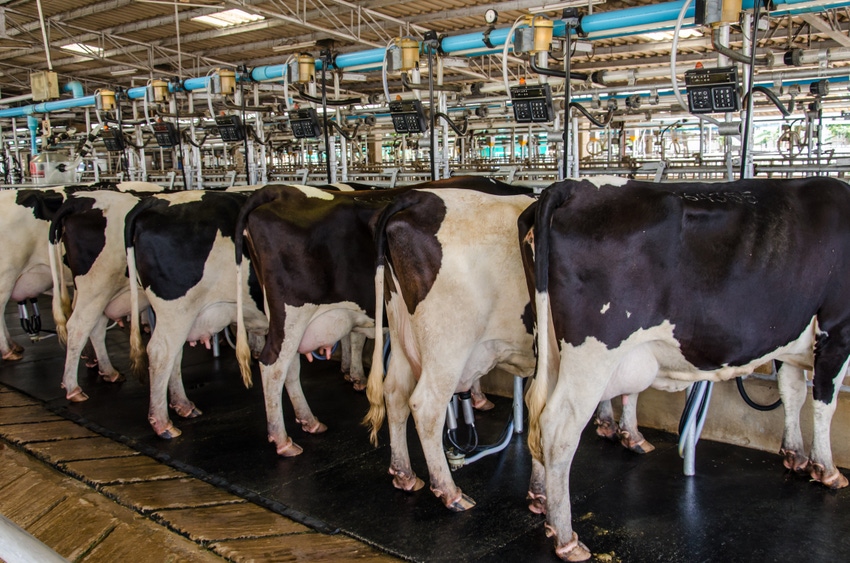By implementing strategic dry cow protocols, producers can eliminate mastitis infections that negatively impact milk production.
December 30, 2019

Intramammary infections present at calving can reduce milk yield by 5% throughout a dairy cow’s upcoming lactation, according to Boehringer Ingelheim.
This can be problematic for dairy producers, as cows are especially susceptible to infection in the first week of the dry period and for the three weeks leading up to calving, the company said in a recent announcement.
“When cows stop milking after 300 days, often three times per day, there are a number of factors that increase the risk of intramammary infections,” said Dr. Curt Vlietstra, a veterinarian with Boehringer Ingelheim. “By implementing strategic dry cow protocols, producers can eliminate current intramammary infections and prevent new infections from forming prior to calving.”
To set cows up for success in their next lactation, Vlietstra offered the following advice:
1. Reduce bacteria in the environment. Cows lie down 12-14 hours a day, and their teats are in direct contact with the material where they rest. Keeping cows clean, dry, cool and comfortable is integral to maintaining healthy udders.
2. Ensure nutritional needs are met. At the start of lactation, cows rely on the mobilization of body fat storage to counteract the negative energy balance they often experience. To ensure nutritional needs are met during the dry period, Vlietstra suggested producers work with a nutritionist to develop an appropriate ration.
3. Treat current mastitis infections. New infections typically occur in 10-15% of cows not treated with an antibiotic at dry-off, he said, noting that by administering an antibiotic, current subclinical udder infections can be treated and new infections may be prevented.
Since 95% of infections at dry-off are caused by Gram-positive bacteria, Vlietstra recommended choosing a dry cow antibiotic mastitis treatment that protects against Gram-positive bacteria including Streptococcus and Staphylococcus aureus species.
Prior to administering dry cow therapy, Vlietstra said it’s important to ensure teats are disinfected properly:
Completely milk out every quarter.
Dip teats in a germicidal solution and allow 30 seconds of contact time before drying each teat with a clean towel.
Disinfect teat ends by scrubbing each teat end with an alcohol-soaked pad, starting with the teats farthest away.
Apply dry cow therapy using a partial-insertion technique, starting with the closest teat (opposite order of cleaning), and massage dry treatment into each quarter.
Follow up by scrubbing each teat end with a new alcohol-soaked pad, starting on the teats farthest away.
4. Supplement the natural keratin plug with an internal teat sealant. The keratin plug is a wax-like substance that acts as a physical barrier and makes entering the teat canal more difficult for invading bacteria. While cows are naturally protected against intramammary infections during the dry period by the formation of a keratin plug in the teat canal, time of closure varies, and some quarters won’t form a plug at all, Vlietstra explained.
“Higher-performing cows are more likely to have difficulty forming that protective seal,” Vlietstra said. “Administering an internal teat sealant can further prevent exposure of the teat canal to bacteria by supplementing the formation of the natural keratin plug.”
For best results, he recommended that producers follow teat sealant administration and removal guidelines closely.
5. Administer a coliform mastitis vaccine. Coliforms are environmental bacteria that are often found in manure and bedding. Coliform species can cause chronic or recurring mastitis infections and are associated with up to 70% of severe mastitis cases, Vlietstra said.
Dry-off is a good time to ensure cows are up to date on all vaccinations, including a coliform mastitis vaccine.
6. Consult a veterinarian. An effective dry cow program is typically multifaceted, so Vlietstra encouraged producers to discuss mastitis prevention and treatment protocols with a local veterinarian.
You May Also Like


.png?width=300&auto=webp&quality=80&disable=upscale)
